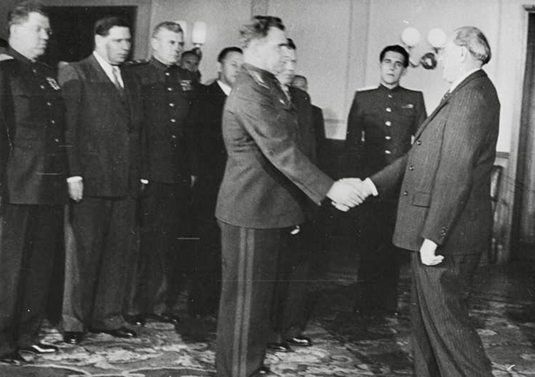Women Warriors in Stalingrad
- Maria A. Kithcart

- Jan 1, 2022
- 3 min read

Photo inscribed on the back with the words “Bandage on the move”—Lieutenant-Colonel V. I. Chuikov stands with a battlefield nurse receiving a dressing change in Stalingrad. Chuikov suffered from a painful, burning weeping eczema on his hands brought on by the stresses of constant heavy combat which required regular dressing changes. This photo is from a family archive of General Semyon Tsvigun—the entire photo collection is located here.
Women filled numerous roles in the Great Patriotic War, and their contributions to the defense of the Motherland did not go unnoticed. Like their counterparts in the US and other Allied nations, Soviet women worked tirelessly in factories manufacturing weapons, vehicles, and aircraft, and provided support in other ways as well behind the battle lines and at the front. True to his nature in fully acknowledging the warriors of the 62nd (later 8th Guards) Army, Vasily Ivanovich was quick to credit the women soldiers of the Red Army for their tenacity, courage, abilities, effort, and indispensability. Even battlefield nurses knew how to use their weapons and were well-prepared to fight. In his book titled The Battle for Stalingrad, Marshal Chuikov recounts the actions of the brave women who unflinchingly served alongside the men of the Red Army all the way to Berlin:
“The deliberate mass entry of women, particularly girls, into active service in the army was not always clearly understood by everyone. There are some who probably still do not understand that they did so as equal builders of socialism and equal defenders of the interests of the workers. This is why, in the war against the Nazi invaders, we saw our Soviet women acting as orderlies, carrying tens and hundreds of wounded from the firing line; as doctors, carrying out operations under air and artillery attack; or as telephonists and radio operators, handling operational conversations and administration in battle. We saw them working at headquarters and in political organizations, where they did army administration work and educated the troops in a spirit of military tenacity. Anyone who visited the front would see women acting as gunners in anti-artillery units, as pilots of aeroplanes doing battle with the German air aces, as captains of armoured boats, in the Volga fleet, for example, carrying cargoes from the left bank to the right and back again in unbelievably difficult conditions. It is no exaggeration to say that women fought alongside men everywhere in the war.
It must also be remembered that in the second half of 1942, when our armies had retreated to a line running through Leningrad, Mozhaysk, Voronezh, Stalingrad and Mozdok, leaving densely populated areas of the country in enemy hands, new recruits were needed. Women volunteered for the army en masse, and this made it possible for us to bring our units and establishments back up to full efficiency. We had whole units (such as anti-aircraft batteries and night-flying PO-2 bomber regiments) in which the majority of gun-teams and crews were women. And it must be said that these units did their jobs as well as the units in which men predominated. We can take two types of work involved in defense operations—anti-aircraft defense and signals—as examples.
The majority of gun crews in the Stalingrad anti-aircraft defense corps, in both anti-aircraft batteries and on searchlights, consisted of women. But the efficiency of these crews and batteries was not the slightest inferior to the anti-aircraft units we saw on the Don and in other parts of the front, where the majority of the crews were men. In terms of tenacity and self-sacrifice, in the battle with the German dive-bombers, the women anti-aircraft gun crews on the banks of the Volga were models of courage. They would stick to their guns and go on firing when bombs were exploding all round them, when it seemed impossible not merely to fire accurately, but even to stay with the guns. In the fire and smoke, amid bursting bombs, seemingly unaware of the columns of earth exploding into the air all about them, they stood their ground to the last. The Luftwaffe’s raids on the city, therefore, in spite of heavy losses among the anti-aircraft personnel, were always met by concentrated fire, which as a rule took a heavy toll among the attacking aircraft. Our women anti-aircraft gunners shot down dozens of enemy planes over the blazing city” (239-241).



